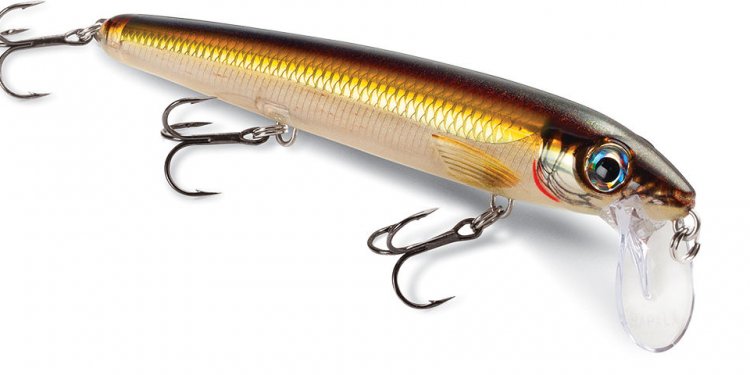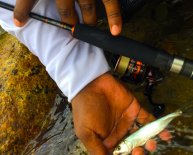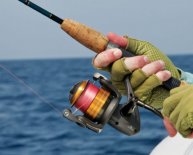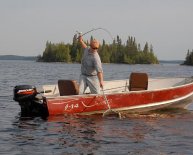
Best lightweight Fishing rod
Comprehending the characteristics of fishing rods allows you to select those who boost your design of angling. Surprisingly, numerous fishermen don’t understand the differences between rod actions and, consequently, hardly ever purchase those suitable for their particular need, be it precision or distance casting, working swimming or topwater plugs, light or heavy jigging, trolling or deep-dropping.
Rod Materials
FIBERGLASS: many trusted rod material, fiberglass is strong, durable and versatile. it is in a position to withstand the abuse on ships and rough seas and is a tried and reliable basic all-around rod material. Disadvantage: weight; it’s difficult for fishermen to identify delicate strikes or bait pickups.
GRAPHITE: A performance-oriented product, graphite leads to smaller diameters and less heavy blanks which can be very sensitive and painful and superb for detecting refined pickups and strikes, plus the feel of this fighting antics of various game fish. Disadvantage: brittle; nicks from banging around on a boat can weaken the blank, making it prone to breakage under pressure because area.
NEW-GENERATION COMPOSITE: These new and effective rods pack plenty of punch in small-diameter and lightweight designs. They’re formulations of both fiberglass and graphite. In short, makers are seeking the toughness and toughness of fiberglass with the susceptibility and lightness of graphite. As a result, a few of these top-quality rods are rated for as much as 200-pound lines, yet these are the size of a 15- to 20-pound whirling or baitcasting pole.
THE ACTION
Elements, for instance the empty product, wall surface thickness and size, play a role in a rod’s strength. But the activity — determined by how far along the blank (starting within tip) the bend associated with the rod stretches — may be the main contributor to a rod’s overall performance. In essence, rods with fast to extra-fast action are best suited for casting precision and solid hook-sets with huge baits and lures meant for larger seafood. A medium to slow action is prime for extended casting distance, pitching live baits, and working smaller lures and baits. Naturally, there are actions in between to assist a rod excel in various specific circumstances.
A parabolic action, which loads up energy for longer casts, is frequently mistaken for fast and extra-fast actions, however it’s actually the reverse. Under pressure, just the initial a few inches of a fast-action rod bends. When just a short section of the rod tip bends whilst the other countries in the blank keeps firm, a rod lends itself to powerful hook-sets and has the muscle mass to stop, change and greatly pressure a fish. Such rods shine whenever live-lining huge baits, like menhaden, goggle-eyes, blue runners and herring, for the likes of big striped bass, amberjack, sailfish, big dolphin, tarpon, snook and cobia, plus whenever jigging or chunking with sizable baits for several of the identical species.
CASTABILITY
For casting precision, fast and extra-fast activity rods provide more speed and power to pitch a lure to a target, thwarting any wind-related deviation. But their particular rigidity decreases casting distance, compared to medium and slow activities, unless hefty lures or baits are employed. For example, we pair a big topwater chugger with a 7-foot, fast-action spinning rod whenever dolphin fishing. The weight of the large connect (1¼ ounces) allows me to achieve respectable casting distances while the rod’s fast activity enables precise presentations perfect for singling out a more impressive dolphin in a school or pitching on borders of working birds. Inshore, but the noisy sound of these a large appeal landing could spook fish, however a lighter rod with an easy and on occasion even a medium action affords me casting precision with additional refined baits.
In medium-action rods, the bend is a bit more obvious than in fast-action designs, usually expanding from the tip to nearly midway down the blank, according to the particular pole and also the materials. Plus the bend is also more intense on slow-action rods.
Typically, the greater pronounced the fold, the greater amount of energy the pole loads up. Which’s mainly exactly how casting distance is created. Regrettably, because of this “load up” plus the not enough stiffness near the rod tip, casting precision suffers. Nonetheless, the gentler deliveries among these two actions — or any combination of all of them — tend to be chosen when pitching real time baits from a distance to online game fish, particularly cobia, barracuda, tarpon, snook, purple drum, education bluefish and striped bass, as baits tend to be less likely to want to travel from the hook. Besides, medium to slow actions are great for light jigging and soaking bait for aforementioned species, also fluke, blackfish, sea bass, and smaller grouper and snapper.
Moderate to slow actions usually advertise better hook-sets, specifically with lighter and smaller lures. With quick and extra-fast rods, fishermen often pull the appeal away from a fish throughout the attack due to the rod’s rigidity. In contrast, that bit of more time, albeit brief, that it takes in the future tight with a medium- to slow-action rod is normally sufficient for a fish to fully engulf a lure, which in turn results in solid hookups. Plus, when playing a fish, the additional cushion provided by moderate- to slow-action rods frequently prevents hooks from pulling or straightening, and lines from breaking during abrupt surges or leaps and when using hefty stress.
ENERGY FACTOR
Rod energy, never to be recognised incorrectly as rod activity, is merely just how effective the blank is, which is usually categorized by the designated line strengths. For instance, hefty rods accommodate outlines from 80- to 130-pound-test, and, apart from getting used to troll for marlin, big tuna and swordfish, they are usually the main new-generation composite whirling and jigging rods progressively accustomed target yellowfin, school bluefin, and — recently — swordfish.
















